In this, my first first monthly report for 2011, I focus on ice loss paths and growth / melt mechanisms, and the significant dynamic differences between feedbacks due to ice extent and feedbacks due to volume. I also explain the relevance of sea ice age. I couple these ideas together and explain why I expect the central Arctic to be essentially ice-free by the end of this Arctic summer 2011.
The major paths by which ice is flushed out of the Arctic Ocean are the Fram Strait and the Nares Strait. I suggest that we may now add a third regular loss path: the North West Passage.
The image below, taken from the March 02 2011 NASA MODIS Arctic Mosaic, shows the state of the ice in Baffin Bay and nearby regions. From my historical researches, I would say that this is the sort of ice distribution that explorers in the 19th century might have considered fairly unremarkable - but at the end of July, not the beginning of March.
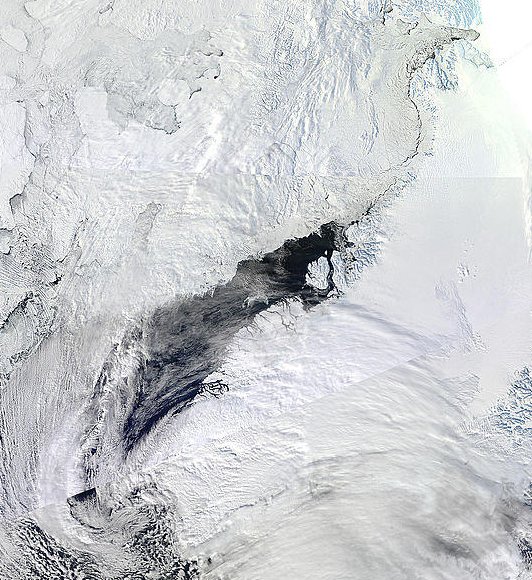
Baffin Bay - March 02 2011
Fram Strait
The most consistent channel for export of old ice from the central Arctic has always been Fram Strait. The rate of ice loss depends on many factors, one of which is the actual extent of consolidated ice. Sheets of ice resembling ice shelves have usually blocked half or more of the width of Fram Strait from the Greenland side. By winter last year there were few remnants of this old landfast ice, with open water from coast to coast.
The multi-year shorefast ice loss of last year will likely continue in 2011. Already, much of the east coast of Greenland which was ice-bound at this time last year is ice free. Scoresby Sound in particular looks to be at a more advanced stage of melting now than it was in May-June of last year.
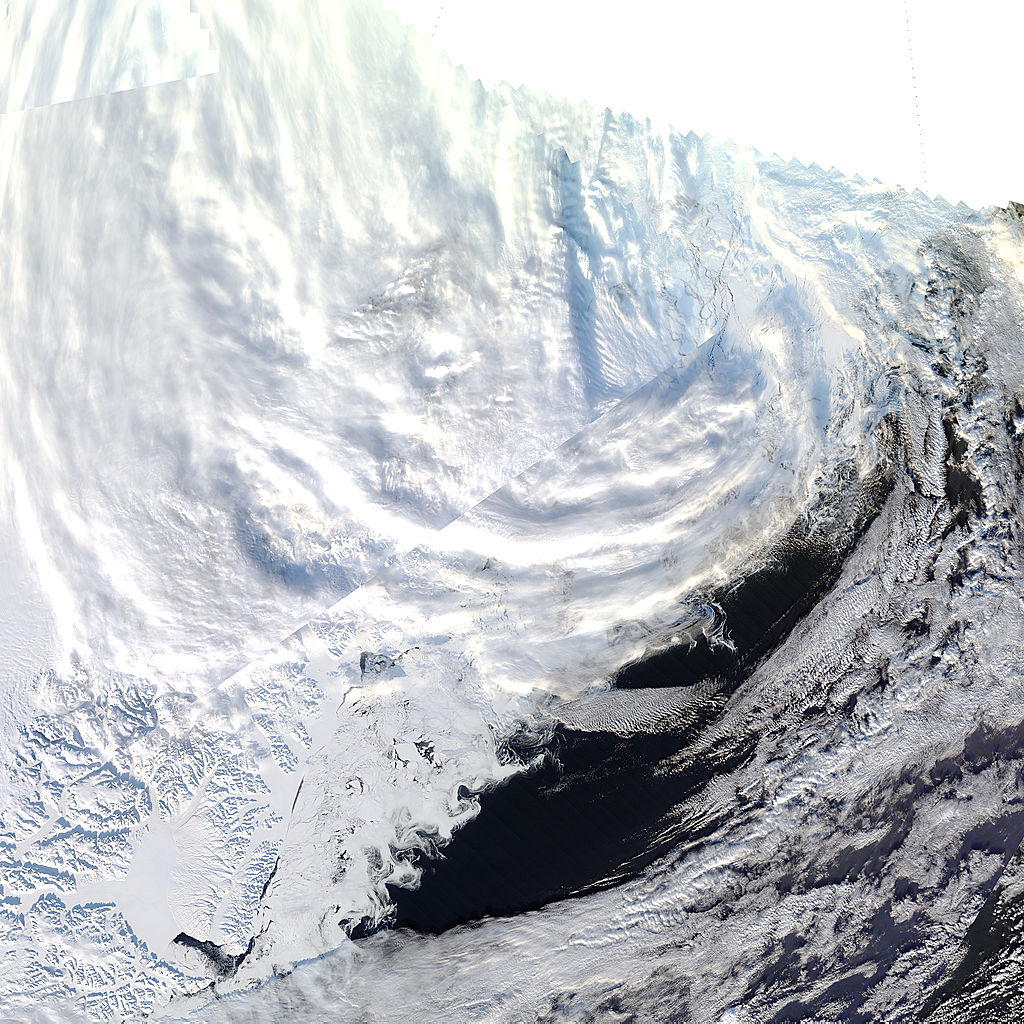
Scoresby Sound March 01 2011 - MODIS terra
The ice along the shore of Greenland serves to reduce the rate of export from Fram Strait. With most of this ice gone, the average flow of ice through Fram Strait will most probably increase.
Nares Strait
Although an ice bridge has formed this winter it is structurally weak. The visual images from MODIS show an apparently normal ice bridge. However, the snow cover hides the weaknesses.
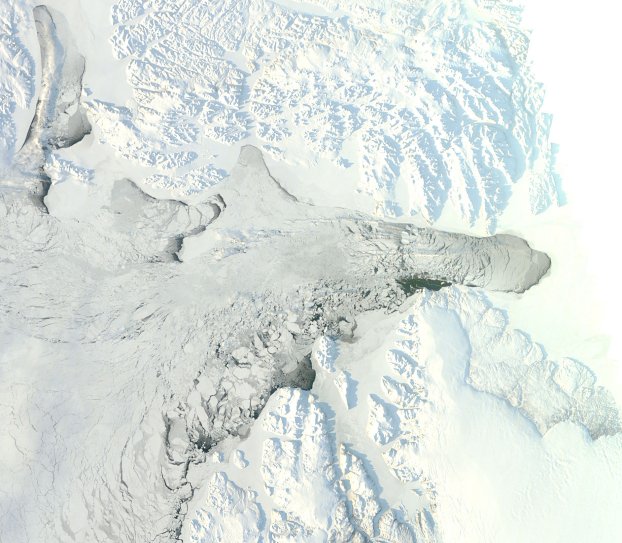
Nares Strait - March 02 2011 - MODIS terra.
Radar images reveal that the ice bridge is not made up of well-consolidated thick multi-year ice as would normally be the case.
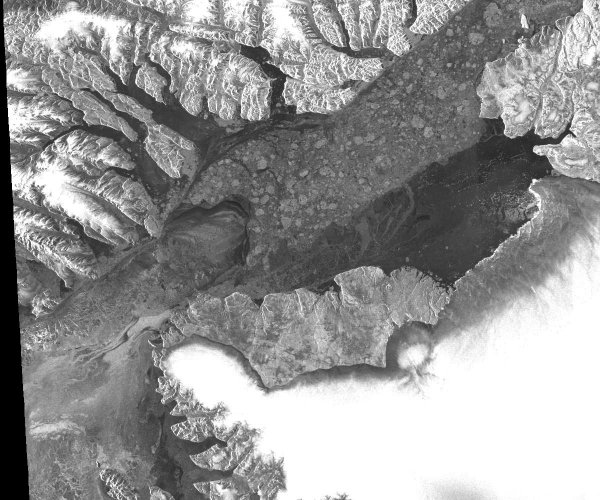
ASAR image of Kane Basin
The chunks of thick ice are frozen together only loosely by new ice, rather than strongly by means of compressive forces and regelation. The Kane Basin is almost entirely covered in new ice, adding nothing to the strength of the ice bridge.
I expect the ice bridge to break up between 2 to 4 weeks from now - earlier if there are any strong gales coming down the Strait.
The North West Passage
There is an ice bridge in the North West Passage, located approximately at the mid-point of the main passage. It shows up clearly in the thermal image below.
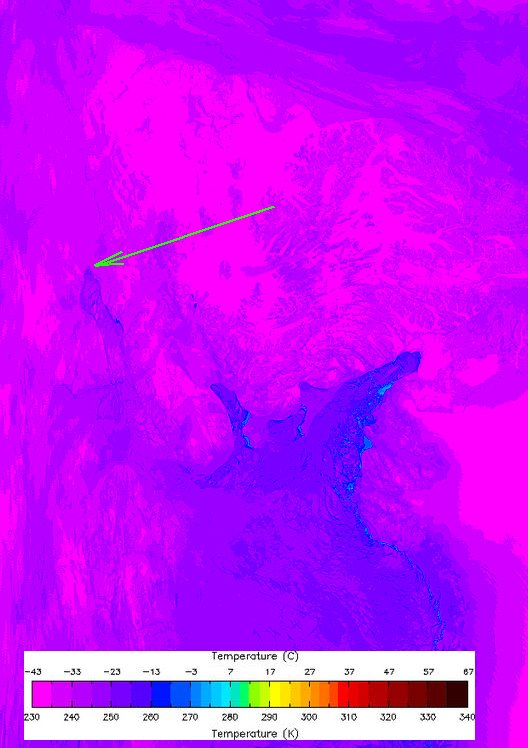
North West Passage - March 02 2011 - MODIS aqua LST
The ice in the main North West Passage is made up of chunks of older ice flushed from the Arctic Ocean in summer 2010, since embedded in new ice. The ice south of the ice bridge appears to be fairly new ice and quite fragmented.
If the general trend towards earlier melting continues this year, I expect the main NWP to be open as a passage for ice export by mid June to end of June.
The age of Arctic sea ice
What [NSIDC] maps show is that the ice got younger, not melted. How does ice get younger?
Steve Goddard
How does a population get younger? If some factor tends to kill off older people or there is a spurt in the birthrate then a population will get younger.
The Arctic Ocean is populated by chunks of ice of various ages. In general, ice will age during its multi-year journey around the Beaufort Gyre or through the Transpolar Drift - of which more is said below. Ice which is exported into warmer waters where it melts has gone to the place where age cannot weary it, nor the years condemn. If such export is of long duration and / or frequent occurrence, then the ice - as a population of bergs of various ages - will get younger.
Although older ice tends to be thicker due to slabbing, bottom growth, frozen meltwater etc., the fact that a particular area of ice is old must not be taken as an assurance of thickness. As each year passes, ice rejects more salt, a driver of the thermohaline circulation. Old ice is almost pure freshwater ice. Young ice is quite salty - too salty to be used to make drinking water. However, if some part of an old floe melts away each summer, the floe will reduce in mass as it ages. It is only when old ice remains in the central Arctic and is compacted into masses that the total mass of old ice remains constant or increases.
When the Arctic sea ice had a fairly constant average annual extent over decadal timescales the export of old ice was matched by the formation of new ice. Average ice age, extent and volume were all fairly constant. Of recent decades, and particularly of recent years, the loss of old ice has not been matched by persisting new ice. Certainly, most of the past winter's meager growth of sea ice will fail to last long enough to become second year ice.
The major characteristic by which the age of a mass of ice may be determined is its salt content. Not extent. Not volume.
Ice extent and volume
If we consider ice in its extent, neglecting volume for the moment, we shall see that the advancing line of summer sun - or the retreat of darkness, which amounts to the same thing - exposes the sea ice to heat from the outer edge inward. This means that we would expect the ice to be more likely to melt at its edges since they are exposed to accumulating heat longer than the center. This is indeed pretty much the case.
At this point I would like to refer my readers to what I call the Best Effect - the fact that midsummer insolation in the Arctic is greater than the contemporaneous insolation in the tropical-equatorial zone.
The Arctic in summer would be something of a tropical sea, but for its ice cover. The ice - for as long as it lasts - insulates the sea from the atmospheric heat by sacrificial melting. It also helps keep the ocean cool due to the albedo effect. The albedo effect is greatly enhanced by any snow cover on the ice - of which more later.
Volume
Let us now consider volume, neglecting extent for now. Obviously, volume without extent is pure thickness, and that is what we are considering.
As stated above, ice protects the sea from atmospheric heat by melting, and from solar heat through its albedo. It is fairly obvious that the greater the thickness of ice, the longer it can persist in its local extent despite melting.
In general, thicker ice is more likely to last into winter and add to its age than thinner ice. Thicker ice is thus - again in general - more likely to become less salty and hence mechanically stronger.
Snow cover
Snow is much more reflective than ice. Just as ice protects the ocean against warming by means of sacrificial melting and albedo, so snow in its turn protects the ice. Thin ice which is awash will lose its snow cover sooner than thicker ice which is holding the snow well above the waves.
Where warm water is causing bottom melt, thick ice will - fairly obviously - persist longer than thin ice. For as long as the ice persists it will protect the snow from the warm water, thus helping maintain the local albedo.
In addition, regional (land) snow cover will help keep the regional atmosphere cool - an effect which will help reduce sea ice loss. Again, if the snow lies on ice - or permafrost - it will be insulated against bottom melting from geothermal heating, thus prolonging the albedo effect.
Although regional snow cover has been quite extensive this past winter, satellite images of the Arctic reveal geographical features in the visible spectra. I take this as an indication of thin snow cover which will melt rapidly in the summer sun.
Ice mobility
Consider how sea ice might grow, starting with an ice-free Arctic ocean. As the zone of 24 hour darkness grows, so does the ice. Ice growth may well be expected to be greatest where 24 hour darkness lasts longest, as heat is radiated into space.
By the beginning of 24 hour sunlight the ice cap has grown into a lens shape: thickest in the center and thinnest at the edge. The summer melt will have most effect where 24 hour sunlight lasts longest, so the heat input will be greatest at the thin edge and least at the thick center.
If no other factors come into play, the ice may grow in volume over the course of years - with no limit to total mass other than ocean depth. The Arctic Basin might well freeze solid. However, if we factor in a transpolar drift and a Beaufort gyre, the picture changes. The transpolar drift carries thin ice to the center of the mass and carries thick ice to the edge. The gyre carries much thick ice towards the Canadian and Greenland coasts.
The net effect of mobility is to prevent the possibility of the sea freezing all the way down. For as long as the gyre and the drift continue they set an upper limit on ice volume.
Factors leading to sea ice loss
The volume of Arctic sea ice will remain fairly constant over the long term for as long as the heat gain during the long Arctic day and the mass loss due to mobility combine to offset the ice growth during the long Arctic night.
Any constant or increasing factor which tends to retain heat during the winter or enhance it during the summer will cause a long-term trend of ice loss.
Any constant or increasing factor which tends to make the ice more mobile will cause a long-term trend of ice loss.
Any constant or increasing factor which tends to warm the ocean and enhance bottom melting will cause a long-term trend of ice loss.
The increase in greenhouse gases - most notably CO2 - has increased the blanketing effect of the atmosphere. Predictably, this has enhanced the rate of summer melt on average and has reduced the rate of heat loss to space in winter.
Additionally, the increase in open water area promotes mixing of the water layers, so that cold water layers can no longer be relied on to insulate the bottom of the ice from the warmer waters which exist at depth. I covered one aspect of this, Ekman transport, in a previous article:
I suggest that Ekman transport is sending surface water under the ice where it promotes bottom melting. This would be yet another feedback mechanism. It would accelerate ice loss through thinning, showing up as faster than expected thinning - i.e. volume loss - in the central pack.
July 21st 2010
Biotransport
And Ocean Mixing
Greatly fragmented ice allows waves to penetrate further into the pack and most likely carries the mixed (warm) water into the pack. I have not included this mixing and penetration as a 'given', below, as the concept has not as yet been robustly proven.
Summary and predictions
As this article has become quite long I shall halt at this point and defer discussion of the Greenland glaciers to a follow-up. I shall merely state here that I think that another substantial calving from the Petermann glacier is imminent.
I made the following predictions January 16th 2010 in my article Global
Cooling : Beyond Parochialism
2010:
Many hottest weather records are broken in northern hemisphere.
Summer arctic ice at record low in extent.
By September the Arctic Ocean is freely navigable by both the northern sea route and the north west passage.
2011:
Reduced ice cover affects sea temperatures, in turn affecting Arctic current flows and air movements. Thinner ice, instead of piling up as pressure ridges due to compression effects, cracks into sections due to tension and agitation effects.
The Arctic is virtually ice-free by late summer: there is open water at the North Pole.
The fact of being broadly correct in most of my predictions during 2010 does not mean that I will be proven correct this year in the above and the following predictions for 2011. But I respectfully submit that my successes make my 2011 forecasts more worthy of serious scientific discussion.
Given:
the overall increase in Arctic and sub-Arctic air and sea temperatures,
the great fragmentation of old ice last year,
the great reduction in old ice volume,
the trend of old ice to be pressed against the coasts of Greenland and the Canadian archipelago,
the weakness of the ice bridge - and of sea ice generally - in Nares Strait,
the strong possibility of an open NWP,
I expect that a great deal of ice will be lost via Fram Strait, Nares Strait and the Canadian archipelago. By September the bulk of sea ice will remain only in the area along the coasts of the Canadian archipelago and Greenland, with an extent of substantially less than 4 million km2. - perhaps less than 3 million km2.
By September there will be virtually no ice left in the Arctic ocean older than 2 years.
The ice which remains will be almost entirely 1st year ice.
As soon as the feedbacks combine to accelerate ice loss, the final remaining summer sea ice will vanish very rapidly, so that the following winter will commence with no sea ice cover. I expect this to happen by 2013.
I now hand over to my readers for comment, discussion, etc.
2013 = A TIPPING POINT
----------------------------------------------------------------------------------
Image sources:
http://nsidc.org/arcticseaicenews/
http://rapidfire.sci.gsfc.nasa.gov/
Further reading:
Rainville et al. Observations of internal wave generation
in the seasonally ice-free Arctic. Geophysical Research
Letters, 2009; 36 (23): L23604 DOI: 10.1029/2009GL041291

No comments:
Post a Comment